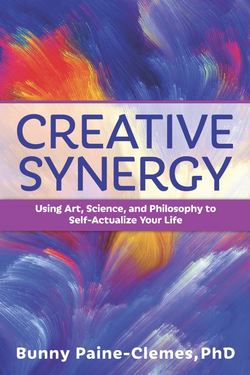Читать книгу Creative Synergy - Bunny Paine-Clemes - Страница 43
На сайте Литреса книга снята с продажи.
Paradigms for Creativity
ОглавлениеOur paradigms determine how we view creativity. Hence Amit Goswami says that creativity theories “are as diverse as the worldviews in which they are wrapped.”72 He identifies three major categories. In the “mechanistic” or “materialist-realist” views, the mind operates as a “Newtonian” “machine” to create logical innovations based on past models and experiences. These theories view creativity as “continuity in human behavior,” with “only one domain of reality in the worldview underlying these theories—matter moving in space-time.” Such “materialist-realist” theories would include problem-solving techniques and emphasize Preparation and Concentration. Barbara McClintock, for instance, testified that her “aha” moments consisted of lightning-fast integration of previous facts. (See Chapter 1.) The “materialist-realist” theory, then, views creativity as thinking based on practice and technique.
In contrast, says Goswami, “organismic theories” stress “becoming” and “development,” with a focus on “a creative unfolding of purposiveness of the universe and of the individual.”73 Vera John-Steiner traces, in Notebooks of the Mind, the way that early childhood interests develop “through multiple apprenticeships.”74 When Einstein was a child, he was given a compass. He testified later to the way in which this gift unfolded the “purposiveness” of his talent by inspiring him with the wonders of science.
The fact that the magnetic needle behaved as if influenced by some hidden force field, rather than through the more mechanical method involving touch or contact, produced a sense of wonder that motivated him throughout his life. “I can still remember—or at least I believe I can remember—that this experience made a deep and lasting impression on me,” he wrote on one of the many occasions he recounted the incident. “Something deeply hidden had to be behind things.”75
More than simply solving problems based on past experience, he was fired by what Sternberg calls the “decision to be creative.” His “development” unfolded as a result.
Finally, says Goswami, “In the idealist worldview, consciousness, not matter, is assumed to be the ground of being. There is transcendence in creativity because consciousness is transcendent.”76 In certain types of creativity, inspiration seems to come from beyond past experience; it is “discontinuous” with past knowledge and practice and seems a gift from the universe. The same idea may be coming to many different artists and thinkers, but its expression will be different, depending on the individual artist, the unique filter through which it emerges. There seems to be a Unified Field, the equivalent of a radio station, beaming information to receivers on its bandwidth.
All of these explanations are complementary rather than exclusive. Like the blind men touching different parts of the elephant, they explain different aspects of the same beast.
For instance, Einstein said, “‘A new idea comes suddenly in a rather intuitive way . . . But . . . intuition is nothing but the outcome of earlier intellectual experience.’”77 Each theory of creativity would have a different explanation for why the “earlier experience” is necessary. The “materialist” would say that practice is necessary to lay down neural patterns and habits. The “organismic” view would say that each experience contributed to Einstein’s development, based on the “purposiveness” created upon receiving the compass. The “causal” or “idealist” view, while not disagreeing with these explanations, would add that practice fine-tunes an individual mind or talent to a portion of the Unified Field. Like the phenomenon of non-locality in quantum physics, creative people need not be physically close to one another to resonate to the same ideas. What is necessary is resonance to the same universal, acquired by empathy with a particular domain or part of the Unified Field. The “materialist” and “organismic” views would claim that Mozart’s genius arose from his childhood experience, hard work, and family background. The “idealist” view would add that Mozart was attuned to musical ideas, so he got symphonies easily. Einstein, attuned to a different part of the Field, received insights about physics
Goswami distinguishes between his “idealist” view, which he calls “fundamental creativity,” and every day “situational creativity” that entails “creating a new product or solving a problem” in a new way. He establishes a theoretical groundwork for this “idealist” view by explaining how new discoveries of quantum physics echo ancient East Indian philosophy.78 In quantum physics, particles become “entangled” and communicate with one another even when they are separated in space, a phenomenon known as non-locality. In ancient Indian philosophy, “monistic idealism” says that everything in the universe is based on the same interconnected consciousness.
This unity of physics and monistic idealism appears also in new theories of cosmology that seem to be echoing ancient Eastern texts such as the Bhagavad Gita. It is possible that we may soon integrate diverse fields such as science, mysticism, and art in a “Unified Field theory” that explains phenomena of nature and art and the connection of universal patterns with individual efforts. By doing so, we will examine the deep structure of theories about the creative personality, process, and product. We will learn to see patterns and follow heuristics that will enrich our understanding and practice of creativity.
A case in point is that concentration techniques developed in other traditions enhance creativity. This book contains some suggestions on how to use them but is by no means the only source. The text for a Stanford course, Creativity in Business, abounds with yogic exercises and concentration techniques. It supplements anecdotes from businessmen with philosophy from the conjunction of Eastern thought and science. Those who integrate the best of many traditions are being practical in this era of globalization.
The fact is, we are now in the midst of an integrative paradigm shift.
